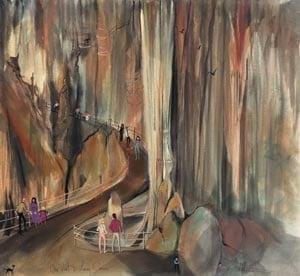Description
Our Visit to Luray Caverns
Luray Caverns, originally called Luray Cave, is a commercial Cave just west of Luray, Virginia, United States, which has drawn many visitors since its discovery in 1878. The underground cavern system is generously adorned with speleothems such as columns, mud flows, stalactites, stalagmites, flowstone and mirrored pools. The caverns are perhaps best known for the Great Stalacpipe Organ, a lithopone made from solenoid-fired strikers that tap stalactites of various sizes to produce tones similar to those of xylophones, tuning forks or bells.
The path that goes through Luray Caverns starts at the entrance. Next it curves throughout the caverns until you reach Dream Lake. Then it goes in circles downwards until it reaches Saracen’s Tent. It goes right to The Great Stalacpipe Organ where it goes next to some big stalactites and stalagmites. Last, it goes to the Wishing Well and goes to a sign where they honor veterans who come from Page County and it climbs out through a small passage where you see the “Fried Eggs” rock formation. At last, it goes out through a smaller passage to the entrance. The entire trek is 1.5 mi (2.4 km) long and takes around 45 minutes to 1 hour to finish the journey.
The caverns are situated in the Shenandoah Valley just to the east of the Allegheny range of the Appalachian Mountains in Luray, Virginia. The valley extends from the Blue Ridge in the north to the south end of Massanutten Mountain. Cave Hill, 927 feet (283 m) above sea level, had long been an object of local interest on account of its pits and oval hollows or sinkholes (known as karst) through one of which the discoverers of Luray Caverns entered.
Luray Caverns does not date beyond the Tertiary period. The cave is developed in dolostones of the lower Beekmantown Dolomite (Lower Ordovician). At some period, niches and already formed chambers were completely filled with water, highly charged with acid, which then slowly began to eat away at much of the softer material composing much of the walls, ceilings and floors. The one particular area that shows this high level of water is Elfin Ramble where water marks of oscillation are highly visible on the ceiling.
The temperature inside the caverns is uniformly 54 °F (12 °C), comparable to that of Mammoth Cave in Kentucky
2004
Includes a Certificate of Authenticity. (See FAQs)
Image Size: 12-1/8 x 13-1/8 inches. Paper Size: 14-1/8 x 15-1/8 inches.

Reviews
There are no reviews yet.